Springtime in Paris
Exploring a less familiar side of the City of Light in its iconic season
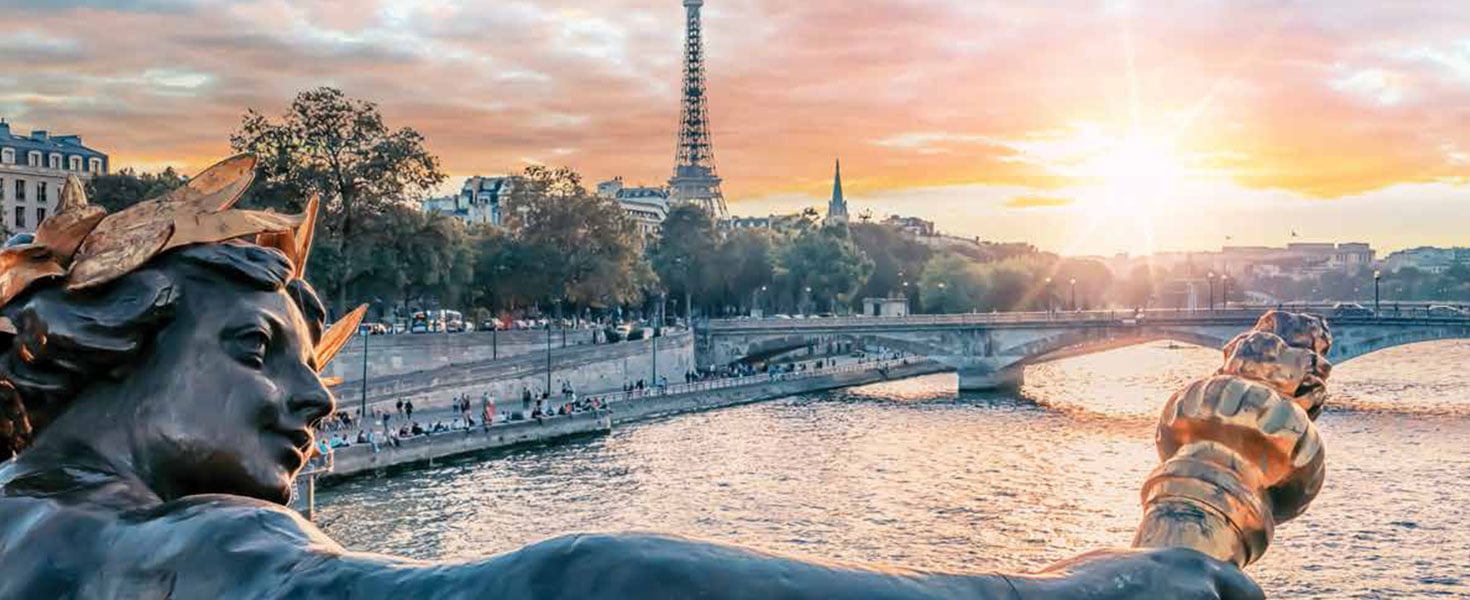

Kids pushing their toy boats in the pond at Luxembourg Gardens. Irises reaching for the cerulean sky in the Jardin des Plantes. Couples holding hands—and glasses of wine—at the outdoor cafés lining Boulevard Saint-Germain des Pres.
Ahhh...who doesn’t love Paris in the springtime?
These quintessential experiences reside at the core of the city, in the first nine arrondisements (municipal districts) that unfurl like a snail around both sides of the Seine River. And while on a recent visit I certainly indulged in them, I also wanted to explore the next layer of less-touristed, primarily residential neighborhoods that spiral eastward on the right bank.
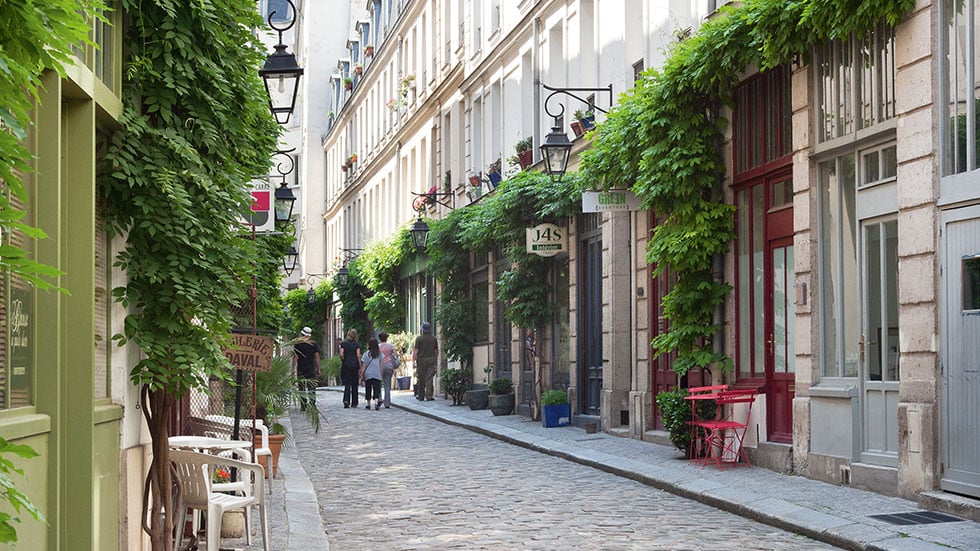
Photos courtesy of Paris Tourist Office
I came for a park, but I also lingered in a cemetery, ambled alongside a canal, dipped into a handful of ateliers and stumbled upon a reasonably priced Michelin-starred restaurant.
My husband, Ray, and I had been to this area briefly in the ’90s but felt like fish out of water amid the then-edgy scene (think graffitied buildings and pulse-quickening nightclubs) that was exploding in the 11th arrondisement of Bastille. In 2016, we returned to celebrate our 25th anniversary at Le Train Bleu, the over-the-top opulent Art Nouveau restaurant in the main concourse of the Gare de Lyon, and found a much more established east end.
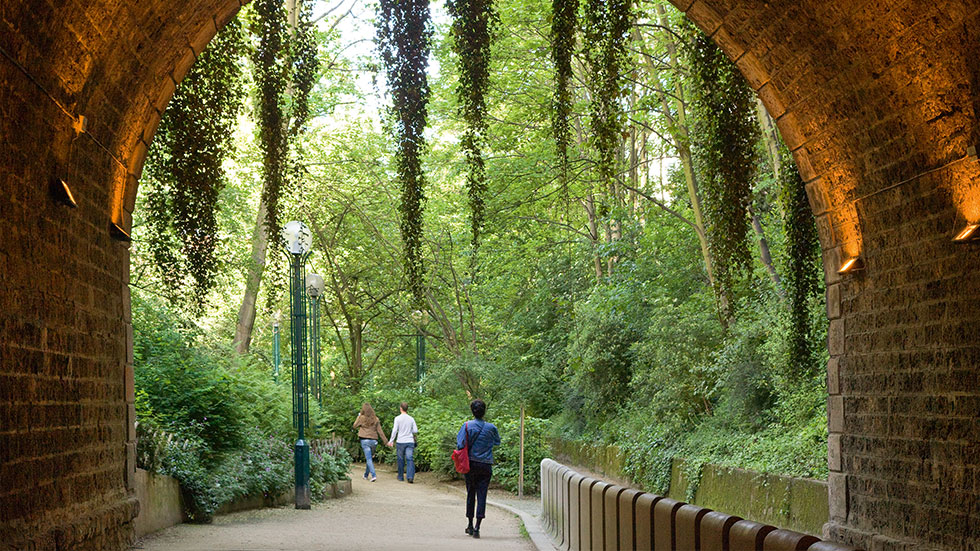
Photos courtesy of Paris Tourist Office
GROUNDS FOR REFLECTION
On this most recent trip, Ray and I based our entire stay in a hotel across the street from that busy railway terminal, where we could easily walk to all that we wanted to see. Tops on the list was a bona-fide tourist attraction: Père Lachaise, the 110-acre cemetery where Edith Piaf, Oscar Wilde and Jim Morrison permanently reside, along with some one million other souls, way out in the 20th arrondissement, about five miles from, say, the Arc de Triomphe.
One day, we arranged to meet Ray’s sister Susan and her husband, Vern—whose trip to Paris had dovetailed with our own plans—at Morrison’s grave.
After paying homage to the Lizard King, Ray and Susan strolled ahead, questing to find the burial place of painter Amedeo Modigliani, whose famously hard-to-locate tomb is usually adorned with flowers and colored pencils. Vern and I followed at a more leisurely pace, almost as if we were meandering through a French village. We walked down lanes paved with Belgian block and populated with street furniture like classic green lampposts and iron signage, stopping occasionally for closer looks at ornate Romanesque and Gothic-style monuments.
Even more than the gravesites—the lipstick-smudged glass protecting Wilde’s tomb was a highlight for me—the beautiful grounds were the truest delight. Considered the world’s first urban garden cemetery when it opened in 1804, Père Lachaise was designed to offer a dignified burial alternative—and leafy respite—to the tightly packed churchyards of a crowded and polluted city. By the mid-19th century, similar cemeteries were popping up in Europe and the US.
Today, both visitors and Parisians come here not only to seek out the graves of its famous residents but also to revel in the peace and quiet found in its verdant allées and curving paths and to birdwatch for the 400 species—including robins, flycatchers and wrens—that nestle in its dense canopy of maples, willows and flowering cherry trees.
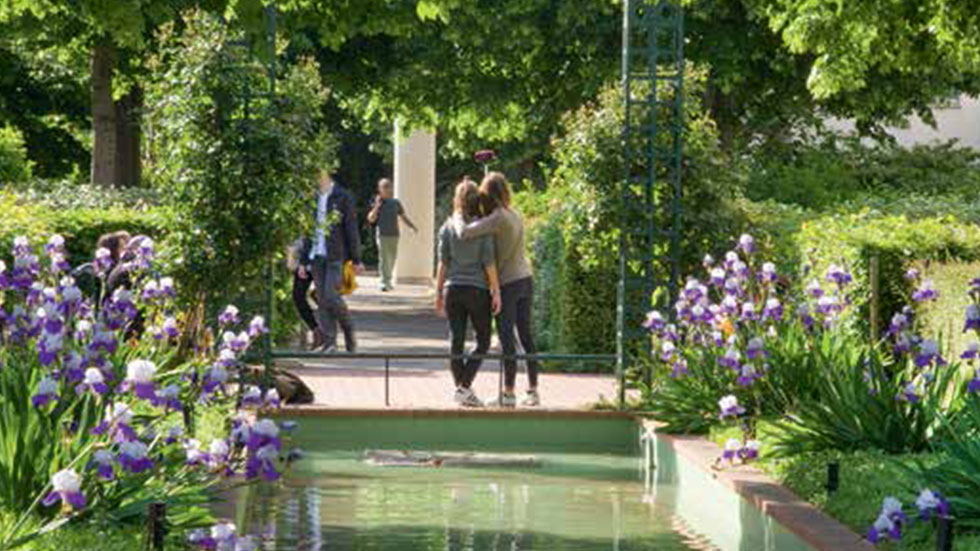
Photos courtesy of Paris Tourist Office
THE ‘REAL’ PARIS
It was La Coulée Verte René-Dumont, though, another groundbreaking open space, that brought me to this area. Named for an agricultural engineer who once ran for president of France and is considered the father of the country’s Green Party, the three-mile coulée verte (an idiomatic expression that translates as “green flow”) is also referred to as Promenade Plantée.
This year marks the 20th anniversary of its transformation from an abandoned 1850s
rail line high above the streets of the 12th arrondissement into an elevated linear park that served as inspiration for New York’s High Line and many other such efforts throughout the world.
Before ascending to the park, I wanted to explore the beautiful red brick structure that supports the whole thing. Tucked into the arches of what’s now called the Viaduc des Arts, about 45 local artisans (including jewelry designers and a luthier), small manufacturers (of handbags, shoes and furniture) and trade specialists (paper conservation and stained-glass restoration) practice their craft and sell their wares here.
I started at Malhia Kent, first examining the weaving machines on display and then roaming the atelier’s wide-planked floors, drooling over racks of Lurex-inflected wools similar to the ones that fashion houses like Chanel have commissioned from the textile designer. Later, I bought souvenirs from Confiture Parisienne, where pear and apricot jams are cooked up in huge steel pots and packaged in tiny tins right on-site.
At Distellerie du Viaduc, a few doors down, I chatted with co-owner Theo Boussion as he encouraged me to sniff delicate test tubes filled with the heady stuff—spices like coriander, juniper and caraway—of his limited-edition gin, anisette and pastis. Boussion, a former graphic designer whose talents are evident in the company’s beautifully packaged bottles, and his good friend Quentin de Montgolfier started the business to pursue their grand passion for great spirits. For them, locating in a fancier neighborhood was never a consideration. “We love being here in the ‘real Paris,’” Boussion emphasized. “We can work on our craft with the other métiers.”

ABOVE THE NEIGHBORHOOD
The next morning, Ray and I began our tour of Promenade Plantée near the western end, climbing up the steps at the intersection of Rue de Lyon and Avenue Daumesnil, just a few blocks from our hotel. (The park is accessible via steel or concrete staircases placed every few blocks, and while we did spot one elevator, it seemed to be in disrepair.)
Once above the street, we were surrounded by masses and masses of roses of every variety and color, twining wisteria and ivy, rampant bamboo and fragrant lavender bushes. A pair of rectilinear reflecting ponds proved especially picturesque, as did arching iron trellises covered in blooms and several murals like Si, Si, La, Fa, Mi, a whimsical depiction of two women dressed in primary hues, one holding a gray cat, the other a bouquet of yellow flowers.
As is often the case when I visit Paris, the walk made me consider whether buying a second home here were feasible. Funny then that as Ray and I stopped to pet a tiny terrier, its owner Jonathan Messey-Smith revealed that he and his wife had recently done just that. We talked real estate for a bit, and I learned that Messey-Smith, a Canadian, was also a writer. He had only recently discovered the elevated park. “We moved here to nudge along our son, who’s studying at the Sorbonne [university],” he said.
I told him that I was here to get to know the neighborhood better, including this promenade and the stores below. “There are stores below?” he interjected. “I’ve been walking up here every day, and I had no idea!”
Evidently, 20 years into its existence, this upstairs/downstairs treasure remains a fairly well-kept secret. Every time Ray and I strolled the park, we found it nicely inhabited but not crowded. Most of its users seemed to be neighborhood denizens, out ambling with their children or jogging with their friends.
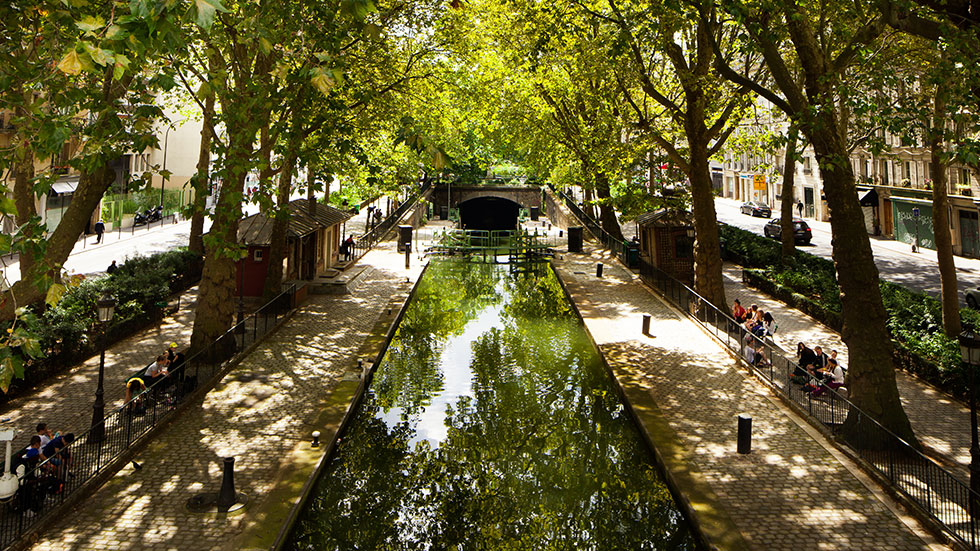
In the 10th arrondissement, the Canal Saint-Martin is a happening gathering spot for strollers and diners. Photo By Alexander Demyanenko/ stock.Adobe.Com
CITY OF SURPRISES
Walking eastward, we peeked into the new and expensive-looking apartments flanking the promenade while we kept an eye out for the district’s post-modernist police station, which eventually appeared on the promenade’s south side. Designed in 1991 in a curious blend of Art Deco and International styles, it’s most notable for the 12 replicas of Michelangelo’s Dying Slave that wrap around the upper stories of the building. The original marble sculpture is housed in the Louvre.
A short time later, we reached a gently arching footbridge that rises over the Jardin de Reuilly, a busy neighborhood park with recreational lawns, terraced gardens and a playground. We exited here—where the elevated portion of the coulée verte ends before continuing for another mile-and-a-half below grade to the Bois de Vincennes at the far eastern periphery of the city.
We then made our way for lunch at the nearby Ground Control, a hangar-like food hall, once part of the Gare de Lyon infrastructure, that offers ethnic eateries (Thai, African), local food trucks, expansive cafeteria-style and outdoor seating, and live entertainment.
For dinners, one evening we explored the trendy restaurants and bars of the happening 10th arrondisement portion of the Canal Saint-Martin, where hundreds of young Parisians smoked, chatted and played music as they dangled their feet from the tree-lined banks.
On another night, we passed Virtus on a walk and were pleased to see some open tables. It drew us in with its friendly interior filled with vintage finds, surprised us with its reasonable (about $100) prix fixe menu and awed us with its Michelin-starred fare.
On our last evening, we stuck still closer to our hotel and enjoyed a simple pizza in the shadow of the atmospherically lit viaduct. While the food was nothing special, the setting was ooh la la. And the name of the restaurant? It was perfect. What better place than one called Le Botaniste to sum up our visit to Paris in the springtime?
